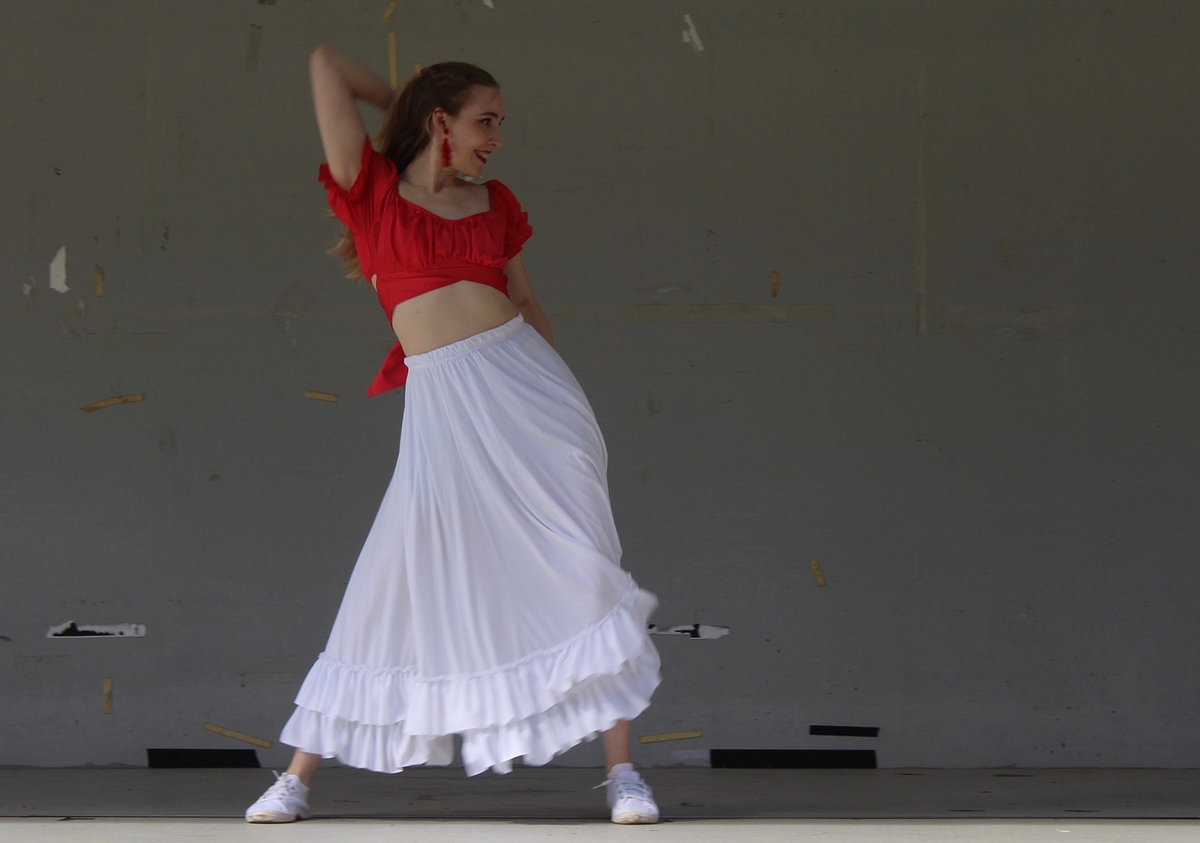
Duvall.
Amanda Duvall, of the New Haven-based dance studio Baila Con Gusto, danced a solo salsa on the stage of the New Haven Green Thursday afternoon with a heady mixture of strength and grace. As the music churned out its unstoppable rhythm, a sense of joy and play surged through her, a smile never leaving her face even as the moves became more athletic. Her enthusiasm, it turned out, was contagious. Five minutes later dozens of people, adults and high schoolers alike, would join her and Baila Con Gusto co-instructor Jason Ramos in a dance and history lesson that deepened understanding as it taught steps.

Robbins and Berlyn.
Baila Con Gusto and Alexis Robbins (of kamrDANCE) and friends were performing on the Green as part of Rhythm Exchange, an ongoing series of midday concerts organized by the International Festival of Arts and Ideas. The series began in August with classical Indian dance. It continues with hip hop on Oct. 13, New Orleans brass band music on Oct. 27, and Day of the Dead festivities on Nov. 3.
Tap dancer Alexis Robbins, joined by Clifford Schloss on guitar and James Berlyn on baritone sax, started off the afternoon with a set of performances of jazz classics by the likes of Duke Ellington, Miles Davis, and John Coltrane. As Schloss and Berlyn provided the melodies and harmonies, Robbins showed just how well a tap dancer could hold down the rhythm; as her movements followed the music, her feet provided the drums. When Schloss and Berlyn took solos, she moved quickly between providing a foundation for their improvisations and answering the calls embedded in their ideas with responses. Schloss and Berlyn also made spade for Robbins to solo herself. Her skitters, clacks, and scratches were their own musical voice, as expressive as any other instrument.
By the time Baila Con Gusto hit the stage, a healthy crowd had gathered on the Green to watch the action — which meant they were just in time to receive a performance, and then a lesson, in bachata and merengue. Bachata, Ramos explained, originated in the Dominican Republic, “and there’s a lot of flavor — blues and other elements — to it. There’s a lot of joy that comes to the dancing.” It came about as a mixture of Caribbean, Spanish, and French influences, using fingerpicked guitar, a bass, and bongo, and a guira. And, of course, those keening voices. When the dance first arose in Dominican culture, in the 1960s, “it was seen as a dance for lowly people, people who were poor and uneducated. But nowadays people dance it around the world, in Europe, Germany, Japan, and China. It’s a dance for everyone.”

A crew of adults and teenagers — including students from Jonathan Law and Joseph A. Foran high schools in Milford, who had been learning about bachata in their AP Spanish classes — lined up in front of the stage to learn. Ramos began with a basic four-step. “To add a little Domincan flavor,” he said, “add a drop,” a dip in the hip. He incorporated a couple turns. The class followed.
“¡Eso!” Ramos said. “You guys learn quick.” He taught then an arm movement that could be pulled into the dance, running the fingers across the head. “In Spanish this is peinar el pelo — comb the hair,” he said.
He tried more complex steps — a two-step with a zig-zag in it. When he double-timed it, to the rhythm of the music, the crowd laughed, realizing how much faster the dance went in tempo. Then they got it.
Ramos then moved backward in time to merengue, an “ancestor” of bachata, which began in the 1800s. It too arose from a mixture of indigenous and colonial cultural forces and became extremely popular. “There was a dictator in the Dominican Republic who wanted to make merengue the national dance,” Ramos said. “So using the military that was occupying the island, and getting musicians playing tambores, drums, he said, ‘we’re going to go one, two, one, two’ ” — revealing how the two-step in modern merengue had marching in its DNA. “This music is a music that derives from joy, from struggle, from trying to liberate yourself through movement and dance. So merengue today, where it stands, is still evolving, just like all music and all movement forms. So you have merengues mixed with rap, merengues mixed with jazz, meregues mixed with other Latin styles like samba, or even Colombian styles.”
He went into the steps, demonstrating how the hips were an integral part of making the dance move right. “The key to the hip shaking, I tell all my students, is to ground yourself. Use your feet, and have the earth give you that energy. So mechanically speaking, you press into the floor, the floor gives it back to you.” He had the students think of climbing stairs, crushing grapes, being stuck in mud. He invited them to inhabit a character to explore the dance further.
“Express as you want to,” he said. Just like any game, “you have the simple rules, and then you break them. You find your strategy.” As the music kicked in, and the students got the hang of it, Ramos gave them even more suggestions, keeping the exchange going.
“Whatever you can imagine, you can do that,” he said. “This is party music, celebratory music, music to move. Right now! Right now!”
Rhythm Exchange continues with hip hop on Oct. 13, New Orleans brass band music on Oct. 27, and Day of the Dead festivities on Nov. 3. Visit the websites of kamrDANCE and Baila Con Gusto to learn more about performances and inquire about lessons.

Wonderful! I hope we see more free dance and music performances and instruction around the city. Dance and music and food brings people from all walks of life together.